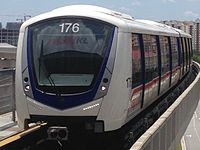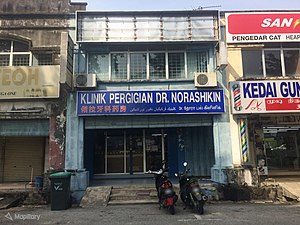Malaysia/Other tagging aspects
| This guide is still under construction. Constructive feedbacks will always be welcomed. |
This section will outline the details recommending the way to tag the rest of elements in Malaysia.
Names
Multilingual names
Official road signs (road names, places and any other points of interest) mainly use the Malay language. Without doubt, this is the value that goes into the name=* tag. There is an exception, for buildings (or places) that features English (and any other language) for example: shopping centres, burial grounds, places of worship, etc. So, in this case, the name=* is what is displayed e.g. on the sign board.
To describe an element's multilingual names, one can make use of these:
- name:ms=* : Name in Malay
- name:ms-Arab=* : Name in Jawi script[1][2][3].
- name:en=* : Name in English
- name:zh=* : Name in Chinese (Simplified Chinese first)
- name:zh-Hans=* : If the place sign uses Traditional Chinese, this tag can be used to input the name in Simplified Chinese[4]
- name:zh-Hant=* : If the place sign uses Simplified Chinese, this tag can be used to input the name in Traditional Chinese[4]
- name:zh_pinyin=* may also be included
- name:ta=* : Name in Tamil
- name:th=* : Name in Thai
- loc_name=* can be useful to describe something in a local context only. There might be some (quirky) nicknames in the local dialect attributed to an element. This is the suitable tag to do so.
The slippy map in the main OpenStreetMap website displays only the value from name=*. To see English names of a particular element (if available), one can benefit from these websites:
Apps such as OSMAnd that uses OSM's database can be set to show the names of places either in the local language, or English names (if available).
We do not adopt dual or triple names yet in the name=* field, because this might be this practice seems like tagging for the renderer (forcing something to be displayed on the OSM slippy map). Let's say, the Parkson department store in Google Maps would not be displayed as Parkson 百盛, isn't it?
Abbreviations
It is strongly advised to give a full name for every element in the map database. Use short_name=*, for every possible short names, separate them with a semicolon (;).
Click here for a list of common abbreviations used in Malaysian street signs.
Tagging example
| Examples | Tagging example |
|---|---|
|
name=Klinik Pergigian Dr Norashikin | |

|
name=Fahrenheit 88 |

|
name=Sri Maha Mariamman Temple |

|
name=Sekolah Menengah Agama Persekutuan Labu |
Administration
- place=* node should be placed at a location which is widely known to all locals e.g. Location of government (Pejabat Dewan Bandaraya, Pejabat Majlis Daerah, Pejabat Penghulu Mukim), Old Town "Pekan Lama" or any other populated centre.
- Total population instead of urban population should be written in population=*, add population:date=yyyy-mm-dd if possible.
| Admin level | Admin boundary type | Corresponding place tag | Comment |
|---|---|---|---|
| 2 | Nation | Malaysia | |
| 3 | Sarawak and Sabah (proposed, if constitution amendment that turn Sabah, Sarawak into territories being passed) | ||
| 4 | State Negeri |
place=state |
|
| 5 | Division Bahagian |
| |
| 6 | District Daerah (Kelantan=Jajahan) |
place=district |
|
| 7 | Subdistrict Daerah Kecil |
place=town |
|
| 8 | Mukim Township |
place=town (major settlements, e.g. Mukim Benut, Pontian) or place=quarter (Mukims with a smaller population, e.g. Mukim Jelutong, Johor Bahru) |
|
| 9 | none | ||
| 10 | Village/Neighborhood community (without official boundary) kampung/taman |
|
|
- For Local Government
- City Council level Cities (Majlis Bandaraya): place=city+population=* (write total population of the whole city council)
- Special case (Seberang Perai and Pulau Pinang): place=region (write the population of the district (e.g. Timur Laut) on the place=city node, where the seat of the district is located, e.g. George Town)
- Municipal Council level Cities (Majlis Perbandaran): place=town at municipal seat with population
- Special case: If the municipal population exceeds 400,000, use place=city at municipal seat and DO NOT add population=*! (in view of huge-population municipals will shade more significant cities) (e.g. Kajang, Klang, Ampang Jaya, Sungai Petani)
- District Council (Majlis Daerah): place=town at district seat without population (in view of huge-population districts will shade more significant municipals)
Waterways
Natural waterways
| Tag | Element | Natural waterways | Photo |
|---|---|---|---|
| waterway=riverbank | Used for larger rivers, to define an area between the opposite riverbanks. | ||
| waterway=river | A moving body of water, usually the main ones. For smaller, shallower waterways, consider using waterway=stream instead.
In Sabah and Sarawak, the tag boat=* can be included where appropriate. Key words: sungai, alor. |
||
| waterway=stream | Naturally formed, narrow waterway. Wider but shallow waterways could be considered as well (e.g. if the water is not deep and people can walk through it).
Key words: anak sungai, charok. |
Man-made waterways
| Tag | Element | Man-made waterways | Photo |
|---|---|---|---|
| waterway=canal | If the name of the waterway contains the word "Terusan" or "Tali Air" or if it looks like a typical canal, it should be tagged as a "canal".
Key words: terusan, tali air and maybe sometimes parit (especially southern states). |
N/A | |
| waterway=ditch | If the waterway is significantly smaller than a typical canal, chances are good that it is a "ditch". | N/A | |
| waterway=drain | If it is made out of concrete or build from other hard materials, it is maybe a "drain". A drain must not necessarily contain water all the time. In dry seasons it could be dry and only be filled while it is raining! If the width exceeds 3 meters and the drain does contain water most of the time consider using waterway=canal instead. |
Railways
| Tag | Element | Railways | Photo |
|---|---|---|---|
| railway=rail | From the railways page, "Full sized passenger or freight trains in the standard gauge for the country or state."
Examples:
|

| |
| railway=subway | "High-capacity public transport generally used in urban areas" Read also subway on Wikipedia. Examples: Rapid KL's Klang Valley Mass Rapid Transit lines.
Examples:
|

| |
| railway=light_rail | "A city passenger rail service running mostly grade separated." Read also rapid transit on Wikipedia. Examples: Rapid KL lines across the Klang Valley.
Examples:
|

| |
| railway=monorail | "A railway with only a single rail, often inner city and above street level." The only example is the KL Monorail Line |
File:An example of Monorail.png |




